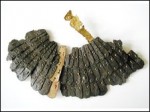Carlisle Castle was first built by William the Conqueror’s son on the site of an ancient Roman fort near Hadrian’s Wall in 1093. It was part of Scotland back then — now Cumbria is part of England — and it has seen many a battle and intrigue over the 900 years of its existence. Mary Queen of Scots was even locked up there for a few months.
Over the past 10 years, there’s been an extensive archaeological dig on the castle grounds. The dig has just officially ended, and the final tally of Roman artifacts uncovered is a staggering 80,000.
Senior executive officer for Oxford Archaeology North, Rachel Newman, said: “The area was very damp 2,000 years ago, and therefore rare evidence survived for how the Romans and their medieval successors lived, in the form of the foundations for their timber buildings, as well as parts of Roman tents and saddles, their shoes, and wooden and leather possessions.
“Many thousands of objects were excavated, including less fragile material, such as pottery, metalwork, both jewellery and everyday utensils, coins, and stone objects.”
“All this evidence provided a wonderful glimpse into how people lived 2,000 years ago, and also in medieval Carlisle, more than 1,000 years later.[“]
Some of the everyday items include nit combs, one with a louse still embedded in the tines, and large numbers of beef bones. Roman soldiers stationed in Carlisle were partial to beef shoulders, apparently. The articulated neck guard, on the other hand, is an extremely rare find.
 The huge collection of artifacts from this decade-long excavation will go on display in the new Roman gallery of Carlisle’s Tullie House Museum and Art Gallery next year. The Tullie museum already has some Carlisle Roman artifacts on display which you can browse in their nifty iRomans website.
The huge collection of artifacts from this decade-long excavation will go on display in the new Roman gallery of Carlisle’s Tullie House Museum and Art Gallery next year. The Tullie museum already has some Carlisle Roman artifacts on display which you can browse in their nifty iRomans website.
I particularly like the Roman version of military dogtags, a bronze disc with the soldier’s name on it worn as part of the armour. I’m also delighted to see wooden tent pegs from the earliest period of Roman habitation before they constructed the permanent fort. For some reason I can’t explain, I’m completely fascinated by ancient tents. Some of those officers’ tents were seriously fancy digs.